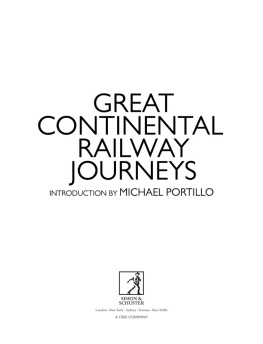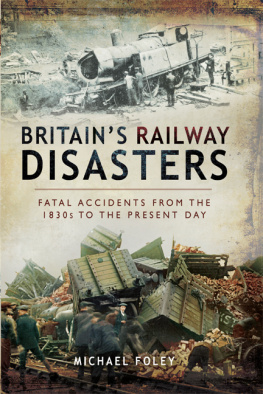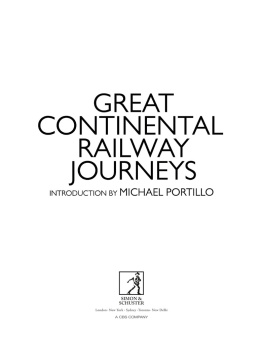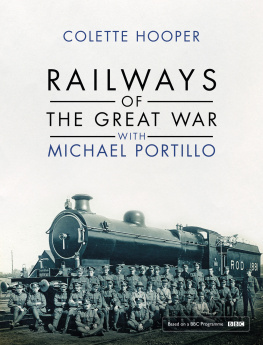GREAT
CONTINENTAL
RAILWAY
JOURNEYS


Destinations

INTRODUCTION
BY MICHAEL PORTILLO
BRADSHAWS GUIDEBOOKS PROVIDE A DEEP INSIGHT into Britains state of mind in the year of their publication.
The guide to the United Kingdom from the 1860s (which I use in the BBC television series Great British Railway Journeys) reveals a nation at the peak of self-confidence. The British empire is the largest that has ever existed and, at its heart, London is the worlds first metropolis. The country leads the world in innovation, invention, science, engineering and manufacture.
But by 1913, the mood has changed markedly. The Bradshaws Continental Guide of that year reveals a loss of self-assurance. Germany has taken the lead in engineering and scientific research. France dominates new industries like car manufacture and cinema. War approaches.
The guide doesnt say that explicitly, but it lists the sizes of Europes armies and navies country by country. Germanys army is vast, Britains tiny, but the Royal Navy is still as large as any two others put together. The book recounts the progress of the Balkan wars up to the moment of publication. It was to be in the Balkans where the fuse of the Great War was lit.
The Europe described in Bradshaws has enjoyed decades of peace. The British have not been involved in a Continental war for nearly a century; and even Germany and France have been at peace for more than 40 years. Its the old Europe of empires: Tsarist, German, Austro-Hungarian and Ottoman. The coming war will sweep them all away. I have the impression that one of the causes of the First World War was that Europe undervalued peace, not realising how its institutions, prosperity and happiness depended on the absence of war.
The old order was threatened by other things too: by terrorists, for example. Among those assassinated were the Austro-Hungarian empress, the Russian tsar, and the Portuguese king and his heir. A bomber narrowly failed to murder the Spanish king and his British bride on their wedding day. British people have been led by the sentimental poems of Rupert Brooke to view their pre-war period through rose-tinted lenses. Perhaps there was honey for tea for some, but there was also intense industrial strife, violence against and by suffragettes, and an impending civil war in Ireland.
More subtly, artists like Picasso, Braque, Klimt and those of the Der Blaue Reiter movement undermined familiar certainties. Painting, literature and even architecture could be revolutionary, especially linked to nationalism, as in Ireland, or throughout the crumbling Austro-Hungarian empire; and in a different way, in an ever more self-assertive Germany.
Travelling by train with a century-old guidebook has been, for me at least, a wonderful way to learn about the political, cultural and social history of our continent. Just as broad advantage is now being taken of the centenary of the Great War to remember and to reassess, so I hope that the Great ContinentalRailway Journeys programmes help us to understand what Europeans stood to lose.
But the programmes are full of joy too. We celebrate the eccentricities of nations as we build castells, people steeples, in Catalonia. I battled a huge mechanical dragon in Germany and impersonated a ski jumper on a zip wire in Norway. I have been beaten with birch twigs in a Russian bathhouse, heated to melting point in a Swedish sauna, and I tumbled from a toboggan in Austria. I have danced my way across the Continent: with a horse in Spain, with a man in Vienna, with a high school graduating class in Warsaw and in a Roman theatre in Bulgaria.
There have been some great railways to admire: the Schafbergbahn powered by a steam locomotive built on a slope, and the line that climbs through tunnels to Europes highest station at the Jungfraujoch. I enjoyed the first trans-Alpine line through Austrias Semmering Pass and the tracks that hug the river banks between the steep vineyards of the Douro valley in Portugal.
You can read history in railways. In what was known in 1913 as the Holy Land, there was a railway for Christian pilgrims from Jaffa to Jerusalem, and one for Muslim pilgrims from Haifa towards Medina and Mecca. But the British feared that that line posed a military threat to India and Egypt, and during the First World War Lawrence of Arabia blew it up.
I like to give a potted history of Russia with three rail stories. Leo Tolstoy, the novelist, was also a social reformer and champion of the peasants at a time of mounting revolutionary sentiment. He died in a station in 1910. After the March revolution of 1917, Tsar Nicholas II signed his abdication in a railway carriage. Then Germany decided to allow Vladimir Lenin to cross its territory in a sealed train like a revolutionary virus, to foment the Bolshevik uprising that October, and so knock Russia out of the war. It must be the most significant train journey of all time.
I hope that the television programmes may be seen as a celebration of the diversity of nations. So many colourful customs have somehow survived the conforming pressures of globalisation. Its a celebration of peace as well. After Europes terrible 20th century, most of our lives are untroubled by war. Even so, I filmed in Russia while Ukrainians were dying, and the tensions in Israel and the occupied territories are palpable. There are Mediterranean countries recommended in Bradshaws that are presently off-limits because of war or terror.
I hope, too, that this book will help you to travel with me through beautiful scenery and impressive cities; to meet entertaining characters; to enjoy new foods; to marvel at extraordinary customs; and to laugh.
If it also stimulates your interest in and love of history I shall be very glad. We are what we are thanks to both geniuses and tyrants, because of both virtue and evil. Most of us are very lucky to live in our magnificent continent in the times that we do.

FOREWORD
WHEN MICHAEL PORTILLO EMBARKED ON RAIL JOURNEYS around Europe, he took the doorstep-sized Bradshaws Guide, published in 1913, as an immutable record of Europe as it was then.
This straight-talking guide is an antidote to the sentimental nostalgia that sometimes accompanies old-style railways, the flawed 19th-century icon that became etched on the ground and in the public consciousness.
The continent had been irreversibly changed by the ingenuity that put locomotives on the tracks some 80 years previously and by the industry drawn along in their wake. They were a triumph of technology, but there were still lessons to learn about safety, comfort and timetabling.
Bradshaws was designed for the tourists who came later, to advise about the customs and practices of foreign lands. Michael walks in the footsteps of those visitors, experiencing Edwardian times from a European perspective and relishing the flavours of life in this bygone era.
Next page










